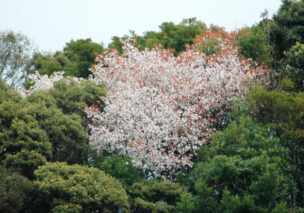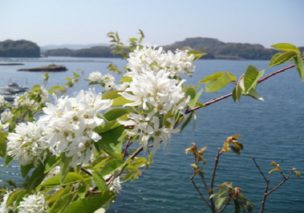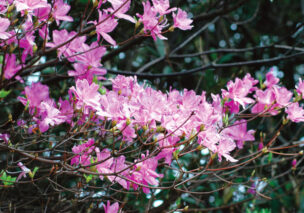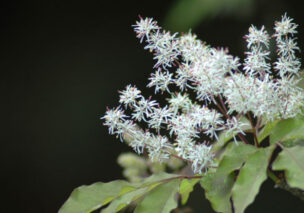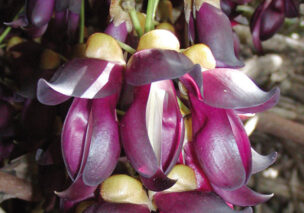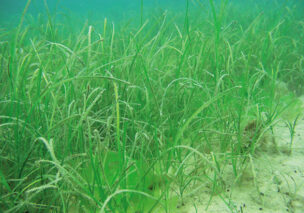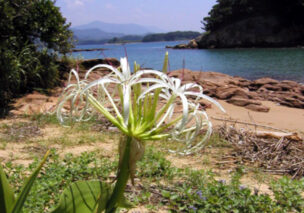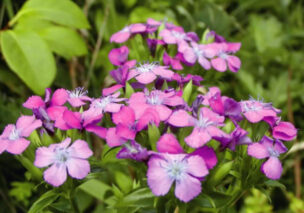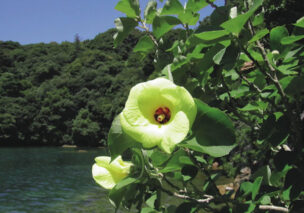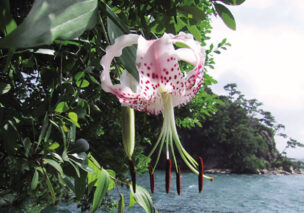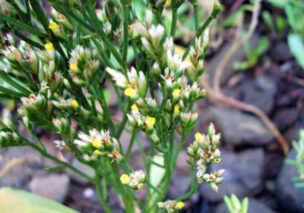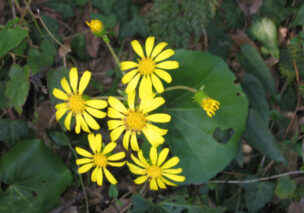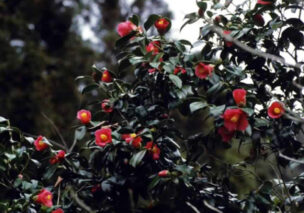九十九島には、海が穏やかで入り江が多いことから、貴重な草花が多く残されています。
佐世保市の花「カノコユリ」をはじめ、国内では4ヶ所しか生育していないと言われている「トビカズラ」や海の宝石「アマモ」。
花々は、島の緑に静かに彩りを添えています。
Yamazakura
late March to early April
Yamazakura is a well-known representative of wild sakura in Japan. In the spring,Leaves and flowers open simultaneously. Smell the morning sun of Kujukushima and the setting sun This is a difficult panorama. When the fruit ripens You can see the gathering of chichi and pecking.
Amelanchier asiatica
From early to mid of April
A white flower, like a piece of torn paper, is attached to the tip of the branch. In autumn, purple-black fruits ripen. The origin of the name was written in Kanji as a shaking tree, and the flower blooming was compared to the arrangement. The sea breeze of Kujukushima seems to welcome sea sightseeing.
Japanese Flowering Ash
From early to mid of April
Densely cluster small white flowers on the tip of the branch. "Aodamo" is derived from the fact that the water turns blue when the branches are cut and immersed in water. Plant scarf! The sea blue of Kujukushima is due to Malva Odamo? ? The trunk is used as a baseball "bat".
Mucuna sempervirens
Mid April to early May
A strain that is considered to be the only indigenous land in Japan grows on Tokoi Island. The flowers bud out of the trunk and bloom. It has the characteristic of blooming in slightly dark places without flowers in bright places. The size of the flower is about 7 cm, and it is a dark purple color reminiscent of a grape peak, with 3 to 20 flowers in a bunch and emits a unique fragrance.
Zostera marina
Mid April to early May
It is a seaweed that grows in the sea. Unlike seaweed such as kelp, it is written as "sea grass". The eelgrass grounds, where many eelgrass grow natively, are said to be the cradle of the sea and are an important place for fry. Another name is Ryugunootohimenomotoyukinokihizushi, which has the longest plant name in Japan.
Swamplily
Late June to August
An evergreen perennial that grows on the coast. The flower opens in the middle of the night, when it smells the most. The origin of the Japanese name is "Hamamannensei" because the evergreen leaves resemble Omoto. It is also known as "Hamayu", using white scales as white cotton. A large white flower is attached to the tip of a thick stem, and it is a representative of Kujukushima flower that makes you feel summer.
Dianthus japonicus
June to October
During the flowering season, many red purple flowers bloom. The appearance of swarming and blooming on the beach is very vivid. The leaves are glossy and thick, the lower part of the stem is woody, and it is a plant resistant to harsh coastal conditions. It is also known as phlegm, because it blooms from summer to autumn.
Lilium speciosum
July to August
It grows everywhere on the island's rocky fields and has red spotted flowers on a white background. It has been cultivated since ancient times, and horticultural species such as Casablanca have been created. In April 2002, it became a flower of Sasebo City. It has been designated as an endangered species due to its limited habitat.
Limonium tetragonum
August to September
A two-year grass growing on the coast. At high tide, it grows in the seawater, but does not wither unlike other plants. The name "Limonium tetragonum" was given in the meaning of the sage growing on the beach, because the shape of the leaves is similar to the sagi used for meals.
Farfugium japonicum
October to November
A perennial plant that grows on coastal cliffs and rocks, and can be found everywhere on the island. Large bright green leaves can be seen throughout the year, and bloom at the flowering season. There are many horticultural species, and young stems can be boiled and eaten.
Camellia japonica
January to April
A beautiful flower that shines red flowers on dark green leaves. It is an important source of nutrients for bulbuls and white-eared buzzards during winter when there are few flowers. Another name, "Katashi no Natsu", seems to have been compared to the firmness of religion of Hidden Christians because of its firmness.








